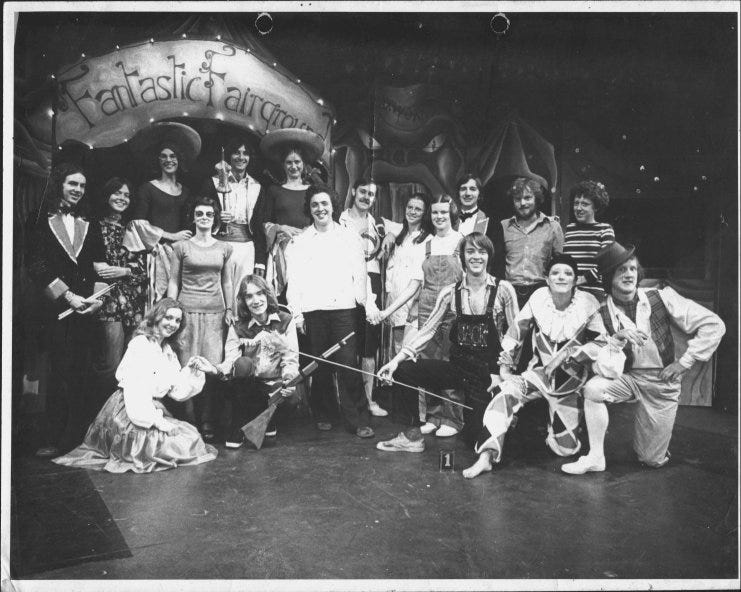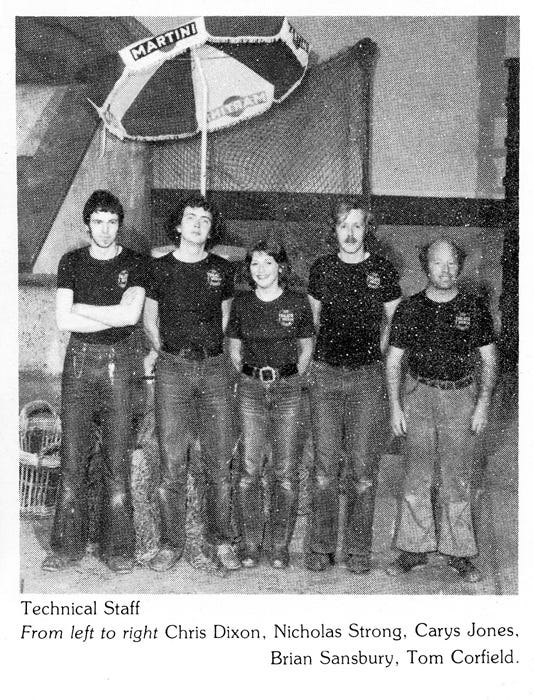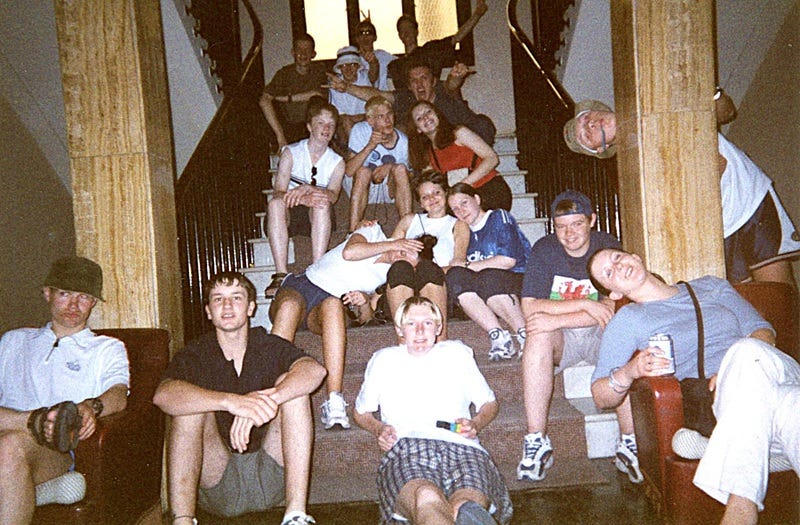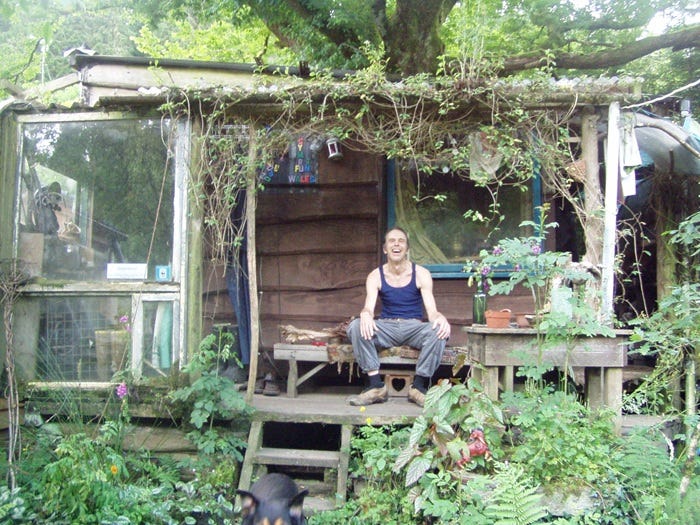Here's a piece that inserted itself into my consciousness, uncalled for, wormed its way up to the surface and popped out with no clear idea of why or where it might be going. Sometimes you just have to let something write itself to get closer to understanding it. So here's my tale of Three Hats.
Hat One: The World of Theatre:
At college I took Classical Studies and Drama; in the latter I specialised in technical theatre, lighting, sound, set design and stage management. I did well on the course and on finishing I was immediately offered a job as technical tutor in the drama department. However, within a day or two of provisionally accepting this post I was then poached by the Technical Manager of Theatr Y Werin (the People's Theatre), part of Canolfan Y Celfyddydau Aberystwyth (the Aberystwyth Arts Centre).
I had done casual work at the theatre for several years, on get-ins, fit-ups and get-outs; that is, unloading visiting companies' sets (scenery) and other luggage on a Monday morning, assembling the stuff on stage and more often, taking it all down and packing it back into their lorry or lorries after the final performance on a Saturday night. The get-outs could go on quite late and I was paid cash in hand, very useful as a student. It also got me used to working in the theatre and seeing many examples of sets and how they were constructed.
above: 1977 University College of Wales drama student summer season production of David Wood’s Fantastic Fairground and my first go at set design. I’m on the left, standing with Lyn. I also featured as the drummer in a band of two, led by the proper musician and now much more famous Neil Brand who writes here on Substack, standing 3rd from right.
I was told that by the Technical Manager that it would be better for me to work in professional theatre rather than the drama department and that I would be acting as Master Carpenter and Stage Technician at Theatr Y Werin. I was flattered (always a bad sign...) and so signed a contract1 and took the job, despite not having trained to such a high level of carpentry. Over the next few years I worked and studied hard, learning both on and off the job, construction techniques, types of material, paints and finishes, set design. Despite having a young wife and son, my world largely revolved around theatre, almost all my friends were theatre folk, almost all my conversations, discussions and even thoughts were to do with theatre. I introduced myself as Chris, the stage carpenter at Theatr Y Werin; the hat seemed to fit.
I was pleased with and proud of my work. I even became a little famous, admittedly within a very, very small group of people, being sought after to build sets for many different groups and small theatre companies. I even think I went a little mad.
above: Theatr Y Werin technical staff, 1980. A happy bunch of collaborative workers- from left to right, set, lighting, costume, sound, stage management.
After three years of working unsociable hours for what was at the time not a lot of money, Lyn and I reappraised our situation. We were a young family, rented house, filled with the white goods and acted out the conventional roles of husband and wife and, as in the Talking Heads song, Once In A Lifetime, began to ask ourselves, How did we get here? And more to the point, is this the life we really want?
So we packed all that in; I took off my theatre hat, Lyn went back to work with horses for even less money, I became a house husband looking after Sam as a three year old and we moved north to live in a shed. Over the next few years, it was as though I was slowly awakening from a dream or a nightmare and remembering who I really was. It felt as though a great weight had been lifted from my shoulders. Crikey, had it really been that bad?
Second Hat: Permaculture Design.
When I first studied permaculture design, I thought I had found something that fitted me like a glove (now I'm mixing my metaphors; better to say the permaculture designer's hat seemed to fit perfectly). Permaculture design was ideal for applying to our own holding and in our own area.
I threw myself into it, organising first an introductory course and following that with a full intensive design course, both run from our local village hall. After the final student had gone home I was asked by the course tutor what my next steps would be. Design and develop our holding, I said, build local self reliance and write. No, there isn't time for that, they responded, the Permaculture Association, Britain, needs teachers and leaders, now, teachers and leaders like you!
above: The 72 hour Permaculture Design Course I facilitated in Llanelltyd Village Hall back in 1991. Another collaborative group and too many amazing people to list them all but here are a few: Andy Langford on the extreme left led the course, at the time one of the most significant designers and leaders in Britain, standing next to Misrule who writes here on Substack. The late, great Phil Corbett is standing 8th from the left and standing 5th from the left is Vendrak Tibor who came across Europe by bus from the Soviet Academy of Science in Koscice, Czechoslovakia.
I allowed myself to be flattered (again...) and within just a few months found myself attending an advanced design course run by Bill Mollison, co-founder of permaculture design and then elected to the Board or Council of management (the Trustees) of the Permaculture Association, Britain and I was off into the world of permaculture design.
I went wherever I was asked to begin with (wherever I felt I was needed), to do talks for gardening clubs, Gwynedd Councils agenda 21 talks, ran introductory and advanced courses, conducted conflict resolution, held slide shows, taught on other folks' courses. I studied and practised hard and was pleased when I was awarded the diploma in permaculture design in 1994, alongside the late, great Phil Corbett and the equally great though not late Misrule. I was even proud to be the 12th diploma holder in Britain.
Third Hat: The World of Formal Education.
Several years after getting the first, temporary planning permission to live on our land, full of enthusiasm and youthful vigour and the vision of permaculture design, we found ourselves increasingly restricted by a lack of resources, particularly money. We felt the need to get a part time job to fund further development so I kept half an eye on the local paper.
After a bit, a job advert appeared and was tempting. I can't remember what it was now but Lyn and I discussed it and discounted it. Skip a few months and another job advert appears, this one more tempting but again, after discussion, we decided against it. Another week or so and a third job advert appears. The fact that this was the third one should be a warning sign- its just far too reminiscent of fairy tales where it is always the third thing that proves crucial.
This job, for a bi-lingual (Cymraeg/English) part time tutor in the technical side theatre, lighting, sound, set design and stage management, on a BTEC National Diploma in the performing arts2 that favoured professional, practical experience over formal teaching qualifications, seemed made for me. So after some discussion, we agreed that I should go for it; I did and I got it.
I remember thinking that in the morning when I awoke, my head was bare before I put on my permaculture designer’s hat. Then, on days I was working at the local college, I would put my new, performing arts technical tutor hat on, on top of my permaculture designer’s hat. With no formal teaching experience I brought with me all the permaculture action learning, learning by doing, collaborative working practices, speaking and listening skills and the like, that I had learned through permaculture design courses. As it happened, this suited the BTEC performing arts very well!
above: Coleg Meirion-Dwyfor performing arts students on our European Study Visit to Barcelona. As with all the student groups I had the privilege to work with, a real mix, to say the least but a lovely bunch! Like herding cats at times but again, capable of extremely good collaborative work.
However, when the course leader left after I’d been there just eighteen months, I was encouraged to take on her role and become full time.. I was flattered (uh oh..) to be told I was probably the best person for the job (thus paving the way for making the same mistake, yet again..). Later, on a staff development day the Principle himself offered me the role of Programme Area Leader for the Arts Sector and soon I was being encouraged to study for a formal teaching qualification, a Post Graduate Certificate in Education.
So although I had no previous experience of the formal education sector, within eighteen months I found myself to be a full time college lecturer, a course coordinator responsible for seven full and part time staff and a programme area leader with responsibility for the visual arts and on top of all that, I became a student myself on the college's PGCE course, as well as attempting to continue my work in permaculture design, at home and away.
During this PGCE course I learned techniques for objective based lesson planning, course design and evaluation, assessment strategies, lesson and subject reviews and more. I became proficient in the technical language that had baffled me completely when I first started at the college. I could write pages and pages of jargon covering reviews, evaluations and my professional development that likely no one would ever read.
I got distinctions in every module I studied and was very pleased and proud to be awarded the PGCE. I even became a little famous and sought after, admittedly amidst a very, very small group of people, (I ended up teaching several modules on the PGCE course). I know I went a little mad.
I had only got the part time job to raise capital to invest in our holding, intending to stay for just a couple of years. It was nine years before I managed to extract myself, by reducing my time each year by one day a week and employing more part time staff. Over the next few years after finally leaving, it felt as though I was waking from a dream or nightmare, or recovering from a period of insanity and remembering who I really was. It was like a great burden was gradually lifted from my shoulders; crikey, had it really been that bad?
Permaculture Design, part two: Taking off the Hat.
While all this college stuff was going on, I was still embedded in permaculture design and attended meetings, courses, convergences, working group meetings all over the country. I Worked on developing the permaculture diploma, designed and ran tutor training courses, inducted and supported apprentices, tried to develop permaculture Cymru, showed several thousands of people around our place, ran advanced design courses in natural re- vegetation, designing for horse keepers, even hosted the other co-founder of permaculture design, David Holmgren, to run a course here.
I taught – teaching being the best method of learning something. Everywhere I went I saw examples of permaculture design I could use in my teaching. If I crossed a field or walked through a wood, my internal voice would be practising how to explain what I saw in a lesson. I applied the principles wherever I looked. I laid out the ethics as an analytical tool over every situation. I took hundreds, perhaps thousands of photographs to use as teaching aids. I even became a little famous and sought after, admittedly amidst a very, very small circle of people! I think I went a little mad.
Over time the glove began to seem too tight and no longer fitted quite right (mixing my metaphors again- glove or hat? Which is it to be??). Or perhaps there were not the correct number of fingers! (OK, here, it is the glove). Finally, after nearly forty years, I decided to take it off. This was not easy! As though the glove had shrunk…
Afterwords, for several years, it felt as though I was slowly awakening from a dream and remembering who I was. It felt as though a great weight had been lifted from my shoulders. Crikey, had it really been so bad?
So what? Some thoughts.
There's something common in these three strands which I first thought was due to signing contracts. In a way, when you sign a contract to take on a job or become employed, you are signing away some of your freedom. What you are doing is committing your future self to certain, sometimes quite severe restrictions in terms of what you are going to do, when and where, either for a certain length of time or forever (!), or rather, until you and the other party to the contract agree to end the contract.
However, when we are driven, say, by idealism, then we may find ourselves taking on similar restrictions of our freedom without the need for a contract. In this case we are bound to these commitments by our own sense of responsibility and our loyalty to others.
Of course, loyalty may also apply even if you have a contract. For example, one of the reasons I found it difficult to extract myself from my role at Coleg Meirion-Dwyfor, was because it was a two year course, so there were always first years who I had got to know and like, who were on the point of becoming second years and I wanted to make sure they had a good learning experience. Also, I knew it would be difficult for a new person to take on my role and that would make it hard for the other staff on the course, who I knew and liked.
What's interesting about each of these examples is that after giving up the roles (taking off the hat, as it were), over the next few years there was a similar sense of waking up out of some sort of dream and remembering who I really was. As though taking on these roles had required me to accept a different way of thinking and doing things, that is, different to something that was fundamental to me.
This is most easily described in my work for Coleg Meirion-Dwyfor where I knew from the start that I would have to adopt methods of working and hence thinking that would seriously constrain me. At first I genuinely thought that I could manage this constraint by, as it were, removing the College hat when I walked off the premises (ha, what an idiot!). Sadly not, the hat remained firmly glued to my head and the work (and the constrained thought processes) followed me home in the evenings and through the weekends. Towards the end of the busiest time, the hat crept down over my ears and eyes and my ability to see a reality outside the college diminished accordingly.
In the worst of the churn, I knew that much of what I was doing was pointless, misdirected, inefficient and repetitive (to say the least!) and that the whole system needed a radical re-design. Yet I was too caught up in the busy-ness to be able to take a step out of the mix and look from an objective position then identify and make the changes that were so obviously required. Sadly, this is the current trap of a considerable number of people around the world.
There's another common element to these three hats in that each role involves working with groups of individuals with specialised skills, on collaborative projects, whether that's a professional or student theatre production or a permaculture design course. In all cases, it was the interaction with such groups that I really enjoyed.
It is said that when you begin in a martial art, you bring with you whatever spirit you have, your own strength and perhaps a very little in the way of technique. Then anyone who has more technique will easily defeat you. So you study and strive to master the various techniques and as you concentrate on technique, your spirit diminishes but you have less and less need of strength. Then anyone who has the same techniques but a greater spirit will easily overcome you. So you have to go beyond technique and use only spirit.
In each of these three roles, I learned technique. In the college experience of formal education, I began with very little other than what I had learned through observation of other permaculture teachers but my spirit was strong. After studying and practising on the PGCE course, I became practically all technique and my lessons, while ticking all the boxes when I was assessed, were far less fun, both for me to deliver or for my students on the receiving end.
In permaculture design, back in 1994, David Holmgren talked to me about internalising techniques such as zoning and sectors. He described how all he had to do was walk out the sunny side of a dwelling and stand there and the zones and sectors would all rotate and fit into position around him to suit that particular place, like a mandala. This is going beyond technique. In a similar way, after some forty years of observing natural re-vegetation, I can now look at a landscape and run an internal movie of shrubs and trees growing up, of water filling depressions and backing up through the soil, of where pools and dams fit and fill.
When Lyn and I do anything now, we create internal models and talk about them. We might draw some rough sketch plans as memory aids but we work largely from experience and intuition. For me, images appear, rather than wordy descriptions.
I think for me, the problems with the three roles I've described above, were the commitment of my future self, who I do not know, to actions that my future self has no choice in. I think also that the busy-ness, to the extent of not being able to take time to step back and clearly see the traps I had created for myself, or design my way out of the traps, that busy-ness is the real mind killer. This is not to say that taking on a contract or equivalent commitment is bad or wrong, just that it will inevitably alter our conscious being.
above: me in my place, without a hat; admittedly from a few years ago when I had more hair.
Now, at very nearly 70, I seem to have finally reached a time in my life where I can live as I had intended, all those many decades ago; continue to design and develop our holding, build local self reliance and write.
Many thanks for reading and welcome to new subscribers. Comments are most welcome. Till next time, hwyl! Chris.
Karl Jung, when told by friends that they had got a new job, would say something like, “Oh, I'm so sorry to hear that, let me buy some wine and commiserate with you!” It took me a few goes at contracts to realise what he was getting at.
At the time, 1995, this BTEC Diploma was extremely flexible, with all guidelines, course content and objectives marked as draft or indicative and centres were encouraged to tweak everything to suit their own needs. Sadly, that flexibility was eroded away with each subsequent revision, coming every three years, just when you thought you'd got to grips with it…







I really loved reading this Chris. The pull to theatre and the arts particularly resonantes for me as I am a performance maker by trade. I do lots of other things but that always seems to draw me back, and find its way back to me. Though actually I think there is a lot of crossover between deep creative arts practice and permaculture design practice do maybe that isn't so bad? xx
another lovely piece Chris, diolch. Also one of many past hats, my favourite these days are the 6 coloured ones! I wish I'd known about them 35 years ago, some trajectories may have been different.... but then again, maybe not. Love the PDC picture!!